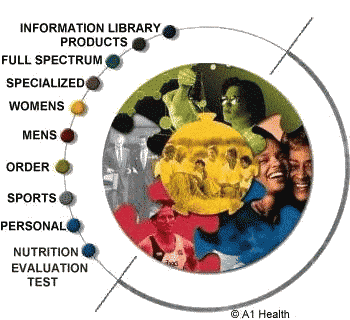Copper is an essential trace element. Human organs with the highest concentrations
are kidney and liver, followed by brain, heart and bone in decreasing order.
These organs contain more than half the copper in the body. More than a dozen
enzymes depending on copper for their activity have been identified; the metabolic
conversions catalyzed by all of these are oxidative. A couple of dozen other
enzymes are affected by copper deficiency with some being more, and others,
less active.
In animals the main organ systems affected by copper deficiency are bone,
brain and nervous system, and heart and blood vessels. The first adverse effect
of insufficient copper discovered nearly 70 years ago was anemia from impaired
utilization of iron. Infertility and spontaneous abortion also have been found.
In more than 30 men and women successfully depleted by copper under controlled
conditions abnormalities of the electrocardiogram, blood pressure regulation,
glucose tolerance, and lipid metabolism (increased cholesterol in blood plasma)
have been reported. Measurement of copper in blood plasma is not very useful
in assessing nutritional status because of its sensitivity to hormonal and
inflammatory influences.
Diet recommendations: The Estimated Safe and Adequate Dietary Intake
range of copper for adults of all ages and both sexes is 1.5 to 3.0 mg/day.
For infants the range is 0.4 to 0.6 mg/day; this is substantially more on
a body weight basis than that for adults. Usual intakes in the U.S. average
1.2 and 0.9 mg daily for men and women, respectively, with about 30% of daily
diets being below l mg. Intakes below 1 mg have produced potentially adverse
changes in physiology (above).
Food sources: From among 235 foods arranged in order of increasing
copper, fats and oils, skim milk, yogurt, mayonnaise, jelly and jam, sugar,
corn, tuna and lettuce are representative of the lowest one fourth of foods.
Legumes, some ready-to-eat cereals, mushrooms, chocolate, seeds and nuts,
crab, peanut butter, liver and oysters are representative of the highest.
Copper intake can be improved by following the Food Pyramid. Copper absorption
is relatively unaffected in comparison to iron or zinc by food type with absorption
generally being in the 40 to 60% range.
Toxicity: Copper is comparatively non-toxic when compared to other
trace elements, with the possible exception in some forms of childhood cirrhosis.
Usual daily diets in the U.S. rarely contain more than 5 mg; an occasional
intake of 10 mg probably is safe for adults. In contrast, dietary supplements
of zinc approximating the Recommended Dietary Allowance (15 mg for adults)
and higher doses produce potentially harmful abnormalities of lipid metabolism
by inducing mild copper deficiency.
Recent research: Anemia has been the focus of copper research for
more than 50 years. Now research on heart and blood vessel health and function
is much more common, along with antioxidant functions, immune function and
brain chemistry. The most important research question may be: to what extent
do diets low in copper in comparison to suggested intakes have adverse effects
on health?
For further information:
Allen, K.G.D. & Klevay, I.M. (1994) Copper: an antioxidant nutrient for
cardiovascular health. Curr. Opinion Lipidol. 5: 22-28
Lei, K.Y. & Carr, T.P. (eds.) (1990) Role of Copper in Lipid Metabolism,
p. 179, 201, 217, 233. CRC Press, Boca Raton, FL
O'Dell, B.L. (1990) Copper. In: Present Knowledge of Nutrition (Brown,
M.I., ed.) 6th ed., pp. 261-267. International Life Sciences Institute, Washington,
DC.
 LIBRARY
LIBRARY
 PREVIOUS PAGE
PREVIOUS PAGE
 ZINC
ZINC
 REQUEST YOUR FREE EAGLE PRODUCT INFORMATION
PACK: INFOPACK@eagle-min.com
REQUEST YOUR FREE EAGLE PRODUCT INFORMATION
PACK: INFOPACK@eagle-min.com

INDEPENDENT
SupraLife Distributor
For personal service Call:
A1 Health
TOLL FREE ORDER EXPRESS HOT LINE :888-441-4184
9 AM Till 7PM EST
 e-mail: info@colloidal-min.com
e-mail: info@colloidal-min.com
